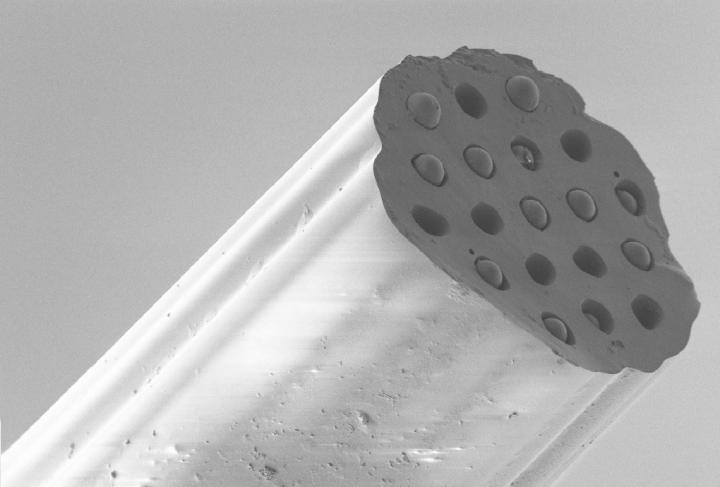Tiny probe that senses deep in the lung set to shed light on disease

This hair-sized probe can measure key indicators of tissue damage deep in the lung. Credit: Michael Tanner, Herriot-Watt University and the University of Edinburgh
The new technology could pave the way for accurate monitoring of tissue in areas where existing technologies cannot reach.
Experts say the probe can pick up tiny changes in tissue health and could improve how patients are assessed and treated, specifically those on ventilators in intensive care.
Lung diseases are one of the leading causes of death and disability in the world. Despite significant advances, little is known about how disease develops in patients suffering from pneumonia or lung injury.
A team of scientists developed the probe, which comprises an optical fibre about 0.2mm in diameter that holds 19 sensors.
Each sensor can measure different indicators in tissues, such as acidity and oxygen levels, which provide important information on the body's reaction to disease processes.
Researchers have designed the technology to offer fast, accurate measurements and the flexibility to add more sensors.
Experts say the technology is widely applicable to other regions of the body and could be used to aid the understanding of inflammatory and bacterial diseases.
The research was supported by the UK's Engineering and Physical Sciences Research Council (EPSRC) through support of the Proteus consortium, which includes the Universities of Edinburgh and Bath and Heriot-Watt University. It is published in Scientific Reports.
Dr Michael Tanner, Proteus Research Fellow at Heriot-Watt University and the University of Edinburgh, said: “This research is a great example of collaboration across disciplines to tackle healthcare challenges. These new methods, if taken to clinic, will lead to novel insights in disease biology. Our aim now is to expand the number of unique sensors on this miniaturised platform to provide even more information.”
Media Contact
More Information:
http://dx.doi.org/10.1038/s41598-019-44077-7All latest news from the category: Life Sciences and Chemistry
Articles and reports from the Life Sciences and chemistry area deal with applied and basic research into modern biology, chemistry and human medicine.
Valuable information can be found on a range of life sciences fields including bacteriology, biochemistry, bionics, bioinformatics, biophysics, biotechnology, genetics, geobotany, human biology, marine biology, microbiology, molecular biology, cellular biology, zoology, bioinorganic chemistry, microchemistry and environmental chemistry.
Newest articles

Superradiant atoms could push the boundaries of how precisely time can be measured
Superradiant atoms can help us measure time more precisely than ever. In a new study, researchers from the University of Copenhagen present a new method for measuring the time interval,…

Ion thermoelectric conversion devices for near room temperature
The electrode sheet of the thermoelectric device consists of ionic hydrogel, which is sandwiched between the electrodes to form, and the Prussian blue on the electrode undergoes a redox reaction…

Zap Energy achieves 37-million-degree temperatures in a compact device
New publication reports record electron temperatures for a small-scale, sheared-flow-stabilized Z-pinch fusion device. In the nine decades since humans first produced fusion reactions, only a few fusion technologies have demonstrated…





















